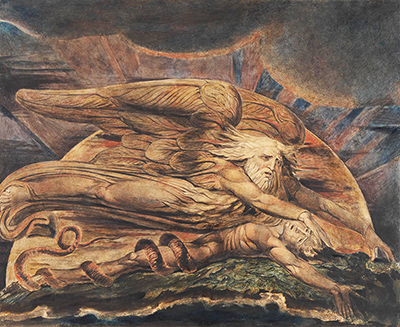William Blake is one of the artists whose work is so immediately identifiable that even a cursory glance at one of his creations will make clear to any art enthusiast who was responsible.
He was the kind of artist who was able to create an entire world, an entire perspective on life, through his body of work. Even when he drew upon religious or mythological narratives in his art, he was able to transform his inspirations into something unique and deeply personal. His piece Elohim Creating Adam, which dates from his period between 1795 and 1905, is based on the familiar Biblical scene of Adam's creation (Elohim being a Hebrew name for God). The scene has been depicted by many other artists, most famously by Michelangelo in the Sistine Chapel. But Blake's interpretation is his, and his alone; it reflects his worldview and his attitudes towards religious orthodoxy and the human condition.
Blake's Adam, the image suggests, does not want to be created. His expression shows anguish, and his posture -- laying flat against he rocks, arm outstretched - suggests Christ's crucifixion or the binding of Prometheus in Greek myth, rather than a triumphant moment of newfound freedom. A snake, which traditionally enters the Eden story at a later point, is prominent: indeed, it is shown coiled around Adam's leg, as though his fate has already been decided out for him. His surroundings are far from the conventional Eden of green grass and blue skies: instead he appears to have been brought into a primal, prehistoric world, a land of stone and fire.
Elohim is likewise portrayed as a bizarrely unorthodox figure, quite unlike the majestic depictions of God of Renaissance art. His face mirrors that of Adam, showing a similar expression of apparent anguish. He appears to be, again like Adam, only half-formed, his winged body blurring into wisps of smoke. The painting is a bold challenge to convention: a vision of humanity's creation as imagined by William Blake, and Blake alone.
If you are looking for an artistic print that will prove to be challenging and provocative to all who see it, then Elohim Creating Adam by William Blake will make a perfect choice. There is a good reason why Blake's work continues to fascinate more than two hundred years later: it is art that tells a story, a grand narrative based on familiar Biblical or mythological elements but filtered through the eye of one of humanity's greatest visual artists. What better print to choose than the image depicting the start of that narrative: Elohim Creating Adam?




